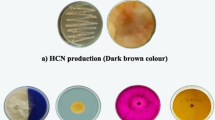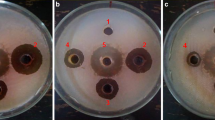Abstract
This study was conducted to investigate the effect of the biofertilizers Azotobacter chroococcum and Pseudomonas fluorescens with metribuzin in soil on growth and development of tomato (Solanum lycopersicum L.) in competition with weeds. An experimental design of randomized complete blocks with 13 treatments and 3 replicates was performed. Three levels of metribuzin including 500, 1000 and 1500 g ha−1 were soil inoculated. The results reveal that tomato could better grow (considering the morphological and physiological characteristics) in competition with weeds when the biofertilizers and low doses of metribuzin are used interactively. The biofertilizers decreased the environmental stress of competition with weeds on tomato and showed no significantly positive effect on the dry weight of weeds. All the crop characteristics were significantly influenced by the biofertilizer treatments. It could be concluded that tomato survives better under the stress derived from weeds competition when biofertilizers and lower doses of metribuzin are applied.
Similar content being viewed by others
References
Ashton FM, Crafts AS (1973) Mode of action of herbicides. Wiley, New York
Barea JM, Pozo MJ, Azcon R, Azcon-Aguilar C (2005) Microbial cooperation in the rhizosphere. J Exp Bot 56:1761–1778
Briceno G, Palma C (2007) Influence of organic amendment on the biodegradation and movement of pesticides. Environ Sci Technol 37:233–271
Chad W, Edward G, Bork W (2006) Fertilization augments Canada thistle (Cirsium arvense L. Scop) control in temperate pastures with herbicides. Crop Prot 26:668–676
Coleman WK (2008) Evaluation of wild Solanum species for drought resistance: 1. Solanum gandarillasii Cardenas. Environ Exp Bot 62:221–230
Huang Y, El-Gamry AM, Xu JM (2001) Assessment of two sulfonylurea herbicides on soil microbial biomass N and N-mineralization. Egypt J Soil Sci 41(1–2):187–203
Kim KK, Jordan D, MacDonald GA (1989) Entrobacter agglomerans, phosphate solarizing bacterial activity in soil: effect of carbon sources. Soil Biol Biochem 89:995–1003
Mallik MA, Tesfa K (1985) Pesticidal effect on soybean-rhizobia symbiosis. Plant Soil 85:33–41
Milosevic NA, Govedarica MM (2002) Effect of herbicides on microbiological properties of soil. Proc Nat Sci 102:5–21
Peter MH, Chen IT, George K (2002) Gene action and heritability of high temperature fruit set in tomato. HortScience 37(1):172–175
Sharififar A, Ghorbani H, Sarmadian F (2016) Soil suitability evaluation for crop selection using fuzzy sets methodology. Acta Agric Slov 107(1):159–174
Strasil Z, Vorlicek Z (2002) The effect of nitrogen fertilization, sowing rate and site on yield and yield components of selected varieties of safflower (Carthamus tinctorius L.). Rostlinna Vyroba 48(7):307–311
Yadav RL, Dwivedi BS, Pandey PS (2000) Rice-wheat cropping system: assessment of sustainability under green manuring and chemical fertilizer inputs. Field Crop Res 65:15–30
Zahir AZ, Arshad M, Frankenberger WT (2004) Plant growth promoting rhizobacteria: applications and perspectives in agriculture. Adv Agron 81:97–168
Author information
Authors and Affiliations
Corresponding author
Rights and permissions
About this article
Cite this article
Safarpoor, M., Faraji, M., Kamali, M. et al. Effect of Biofertilizers and Metribuzin on Weeds and Yield of Tomato. Agric Res 7, 89–92 (2018). https://doi.org/10.1007/s40003-018-0299-5
Received:
Accepted:
Published:
Issue Date:
DOI: https://doi.org/10.1007/s40003-018-0299-5




